Yoga Poses Pregnant Women Should Avoid
Plus, which to do instead. By Beth Donnelly Cabán
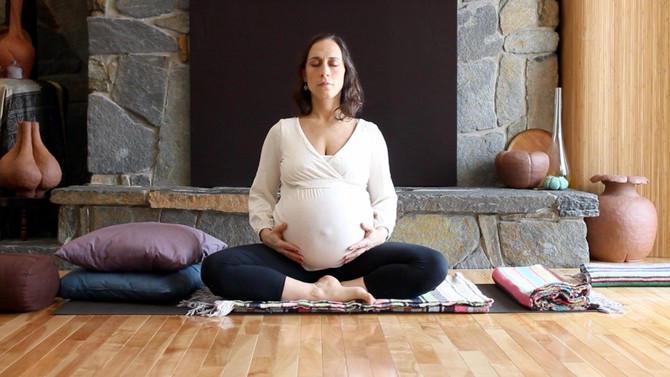
Photo: Joshua Sitron
Most pregnant women are aware of yoga poses they should stop doing, like cobra, locust and bow, all of which you lie on your belly for; and, poses that compress the abdomen, like head to knee or seated forward bend. But here are few others that can cause problems (plus, a few options for modifying).
Half or Full Lotus Pose
This hip-opening seated pose serves as a place to center, breathe and focus your attention inward. But in pregnancy, your blood volume increases dramatically and blood-vessel walls relax to accommodate this extra blood, making you more susceptible to edema (swelling) and varicose veins. Sitting in this cross-legged seat all too easily cuts off circulation in the legs and feet, and can create a tingling feeling from the compression of nerves.
Modification: Sit with the hips open but align one heel in front of the other, with both feet in line with the spine. The hips are open and the pelvis and spine are aligned, but without cutting off circulation of blood and nerves.
Half or Full Lotus Pose
This hip-opening seated pose serves as a place to center, breathe and focus your attention inward. But in pregnancy, your blood volume increases dramatically and blood-vessel walls relax to accommodate this extra blood, making you more susceptible to edema (swelling) and varicose veins. Sitting in this cross-legged seat all too easily cuts off circulation in the legs and feet, and can create a tingling feeling from the compression of nerves.
Modification: Sit with the hips open but align one heel in front of the other, with both feet in line with the spine. The hips are open and the pelvis and spine are aligned, but without cutting off circulation of blood and nerves.

Photo: Joshua Sitron
Bridge or Wheel Pose
A backbend seems like just what a pregnant woman needs—what with the heaviness of her breasts rounding her upper back, the limited space for breathing as the uterus grows up toward the diaphragm and all that weight on her pelvic floor. But a backbend can put significant strain on the midline of her abdominal muscles. (The midline of the abdomen is made up of collagen fibers that are under the influence of hormones during pregnancy; even the pigmentation of this line changes during pregnancy as the tissues soften and expand.)
Modification: From table-top position on your hands and knees, round your back like a Halloween cat as you exhale; then, extend your spine, looking forward as you inhale. Allow your abdominal muscles to support your baby belly, rather than letting it hang down toward the floor.
Modification: From table-top position on your hands and knees, round your back like a Halloween cat as you exhale; then, extend your spine, looking forward as you inhale. Allow your abdominal muscles to support your baby belly, rather than letting it hang down toward the floor.
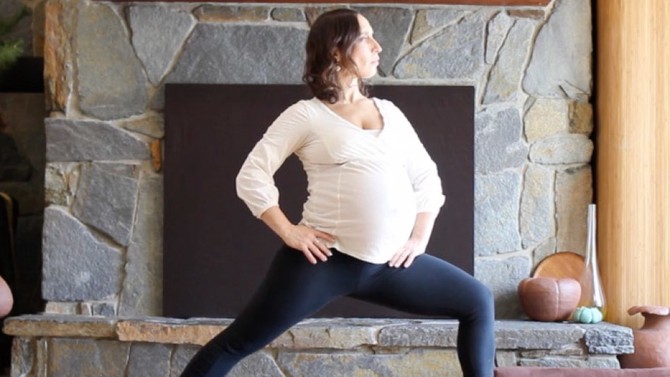
Photo: Joshua Sitron
Triangle Pose
Triangle pose may seem pretty basic; but, it can be difficult for pregnant women to maintain their balance and avoid a sway-back. If I teach this pose in a class, we always use the wall as a point of contact for the back foot, which is usually enough of a reference point for maintaining balance. Another tendency in this pose is to hinge too far over the front leg, collapsing the trunk on the bottom side and over-stretching it on the top side.
Modification: The wider stance of Warrior II creates more balance than triangle pose. A soft knee allows the legs to do a lot of the work rather than the side torso, which is already getting a stretch during pregnancy. Warrior II strengthens the legs and supports circulation throughout the pelvis. Start out by placing the hands on the hips and notice the alignment of the pelvis. Does it tip too far forward like a bowl spilling water? Does it tip to the right or the left? One of the most important concepts we teach in prenatal yoga classes is to first find stability in a pose, and to then find mobility. So, I instruct women to move around in this pose and to not stay in one place. Extend the arms out from the heart, and then move into Peaceful Warrior Pose—dropping the back hand down onto the thigh for stability, and raising the front arm and the gaze up toward the sky. Come back through Warrior II, and then into Side Angle Pose, using the front arm to take support of the front thigh and the back arm and gaze to reach for the sky. Avoid going as deep as possible in any one pose; instead, flow easily through these three poses.
Modification: The wider stance of Warrior II creates more balance than triangle pose. A soft knee allows the legs to do a lot of the work rather than the side torso, which is already getting a stretch during pregnancy. Warrior II strengthens the legs and supports circulation throughout the pelvis. Start out by placing the hands on the hips and notice the alignment of the pelvis. Does it tip too far forward like a bowl spilling water? Does it tip to the right or the left? One of the most important concepts we teach in prenatal yoga classes is to first find stability in a pose, and to then find mobility. So, I instruct women to move around in this pose and to not stay in one place. Extend the arms out from the heart, and then move into Peaceful Warrior Pose—dropping the back hand down onto the thigh for stability, and raising the front arm and the gaze up toward the sky. Come back through Warrior II, and then into Side Angle Pose, using the front arm to take support of the front thigh and the back arm and gaze to reach for the sky. Avoid going as deep as possible in any one pose; instead, flow easily through these three poses.
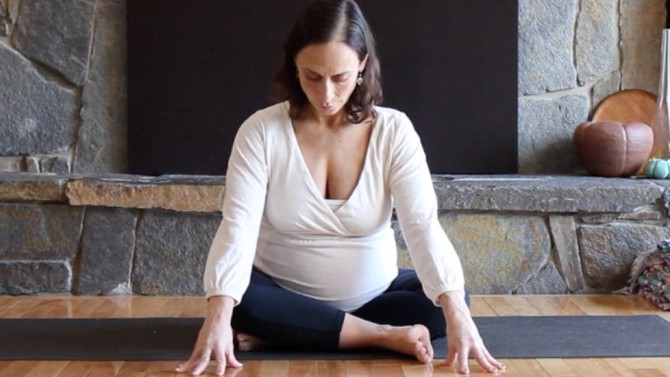
Photo: Joshua Sitron
Pigeon Pose
Pigeon pose gives a great stretch to muscles around the pelvis and the legs, but this asymetrical pose can be too much stress on these joints. One of the primary changes in pregnancy is that connective tissue becomes more pliable. This is highly advantageous for growing another being inside your body, but it also means you're more prone to joint instability. You may be able to go further in a pose because of this, but if you push too hard, pain will often come along. In fact, this is a pose that often feels good while you're doing it, but you could end up waddling home from yoga class with out-of-whack sacroiliac joints.
Modification: From a sitting position, stack one shin on top of the other—right ankle on top of the left knee, right knee on top of the left ankle. Lengthen through the spine and hinge forward just enough to feel it in your hips. Then switch which shin is on top and repeat.
Modification: From a sitting position, stack one shin on top of the other—right ankle on top of the left knee, right knee on top of the left ankle. Lengthen through the spine and hinge forward just enough to feel it in your hips. Then switch which shin is on top and repeat.
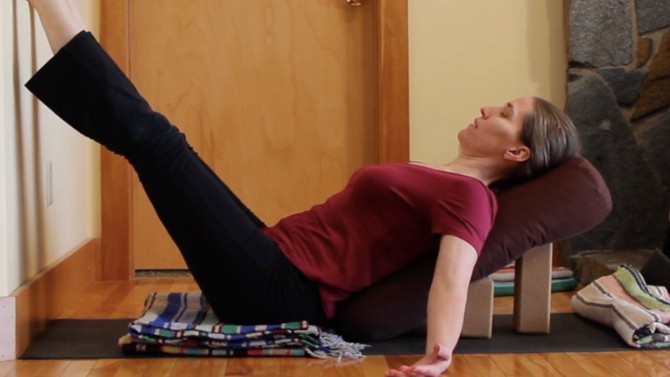
Photo: Joshua Sitron
Inversions: Headstand or Shoulderstand
Full inversions put the weight of the baby, as well as the uterus, placenta, amniotic fluids and umbilical cord, onto the diaphragm, lungs and heart. This is never good if a woman has heartburn—which is a common discomfort of pregnancy. Turning upside down is not necessarily good for the fetus as it gets bigger and begins to settle down into the pelvis head-first.
Modification: A modified inversion with the legs elevated at the wall, and the head and back supported by blankets or a bolster. This relieves swelling in the feet, ankles and legs. Stay in this pose for no more than 3 to 5 minutes.
Modification: A modified inversion with the legs elevated at the wall, and the head and back supported by blankets or a bolster. This relieves swelling in the feet, ankles and legs. Stay in this pose for no more than 3 to 5 minutes.
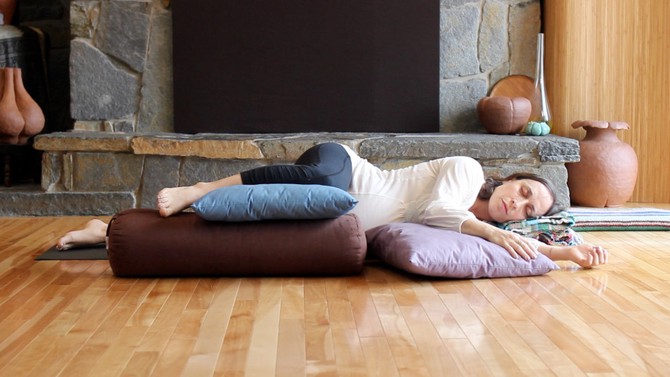
Photo: Joshua Sitron
Deep Relaxation Pose: Savasana
Savasana sounds like a no-brainer—it's just lying on your back. But staying in that position for too long when more than 20 weeks pregnant can make you feel dizzy, nauseous, sweaty, even panicky—all symptoms of supine hypotension, or vena cava syndrome. When a pregnant woman lies on her back, the weight of the baby and uterus compresses the major veins that return blood to the heart. Rolling over to the left side will restore adequate blood flow.
Modification: You will be lying on either side for a few months, so it is worth learning how to prop yourself well in side-lying relaxation pose. Gather up pillows, blankets and bolsters; lie on one side, make sure your head is in line with the spine, supported with pillows or blankets. Make sure the top leg is well supported, keeping the hips stacked and the knee, ankle and foot in line with the top hip. A few blankets underneath the torso below the bottom arm create more space. When properly supported, side-lying pose can be incredibly relaxing.
Beth Donnelly Cabán is a Registered Nurse and childbirth educator who has been teaching prenatal yoga for 20 years. She directs the Prenatal Teacher Training Program at Integral Yoga Institute in NYC and is the consulting expert on The Essential Prenatal Yoga Video series.
Modification: You will be lying on either side for a few months, so it is worth learning how to prop yourself well in side-lying relaxation pose. Gather up pillows, blankets and bolsters; lie on one side, make sure your head is in line with the spine, supported with pillows or blankets. Make sure the top leg is well supported, keeping the hips stacked and the knee, ankle and foot in line with the top hip. A few blankets underneath the torso below the bottom arm create more space. When properly supported, side-lying pose can be incredibly relaxing.
Beth Donnelly Cabán is a Registered Nurse and childbirth educator who has been teaching prenatal yoga for 20 years. She directs the Prenatal Teacher Training Program at Integral Yoga Institute in NYC and is the consulting expert on The Essential Prenatal Yoga Video series.
Published 01/08/2018

